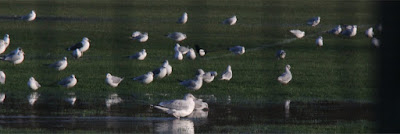 |
| Hoopoe, Collingham |
We live in Interesting Times, sadly, and end the year in for all intents and purposes another lockdown, not what I'd had planned at the beginning of the month, let alone the beginning of the year. But there are worse things than drinking a cup of tea while looking out of the living room window trying to work out whether that's six or seven long-tailed tits bouncing through the sycamores on the railway embankment.
Being in lockdown throughout the Spring migration season put the mockers on my hitting a year list of 200+ again, though I was lucky to catch up with so many birds on their way back. In the end the 2020 total was 180, which is fairly good in all the ciircumstances. Travel restrictions meant I didn't see many seabirds, missing out on auks and gannets, fulmars and skuas. Ticks that would have been "easy" any other years I missed. But I saw some splendid birds, got some lifers and really gave Greater Manchester some birdwatching hammer (and still have a couple of dozen places on a "must pay a visit" list, which seems to be growing faster than I'm ticking off).
 |
| Siberian stonechat, Ashton's Flash |
This was the year I finally got to see my first hoopoe on a bright sunny day as I stood on a cricket outfield watching the bird do the groundsman's job for him as it aerated the grass roots and made inroads on the local chafer grub population. And I was charmed by my first Siberian stonechat as I stood at the edge of an old saltings bed watching it hunting from a perch twenty yards away. My first Sabine's gull was fleeting, frustrating, but memorable, the big white triangular flash on its wings jumping out in the sunlight against the backdrop of a ploughed field. And standing in a muddy field trying to make sure if I was looking at a brown shrike or a red-tailed shrike, either of which would have been an outlandish call for an addition to the life list at the beginning of the year. It took two goes for me to fail to see the wryneck at Horwich, but I got two very nice walks out of the experience and I can still look forward to seeing my first.
 |
| Greater Manchester sites from which I recorded in 2020 |
Locally I've done a lot more walking and a lot more exploration. Ironically it was the full lockdown what did it: up til then I was going out birdwatching perhaps two or three times a week. Going out for a walk being virtually the only permitted reason for leaving the house meant I got into the habit of going birdwatching more often and now I feel I've had a lazy week if I've only been out three times. There are times when I've been fed up of the sites within walking distance (the inevitable consequence of limited green space in suburbia) but there are enough places a short hop away on public transport to give me a change of pace.
So I've found more lesser whitethroats than usual, and my second quail in exactly the same place as my first last year. I know now to look out for "Channel wagtails" (blue-headed/yellow wagtail hybrids) on Chat Moss. And I know which hedgerows to search in Autumn at Hollingworth Lake for passage migrants.
It's interesting to see that Birdguides is stopping treating great white egret as a rarity for most of England and is approaching doing the same with cattle egret in some parts of the country. I saw my first great white egret four years ago, these days I'm disappointed not to have a dozen records a year (even with this year's restrictions I've nine records). I don't often see cattle egrets away from the Sefton coast so I've only seen them a couple of times this year, though both times they'd arrived mob-handed.
 |
| Willow tit breeding numbers (total pairs) in 2018 British Birds 113 p779 |
I hadn't quite realised how important our local willow tit populations are in the national scheme of things until I read the 2018 Rare Breeding Birds report in the December edition of "British Birds."
If, as we must hope, 2021 is less fraught and the pandemic can be controlled or even abated I'm hoping to capitalise on this year's experience to improve my birdwatching tallies and get some very nice walks under my belt in the process. And, of course, there will be mud. Best wishes, all.


















































